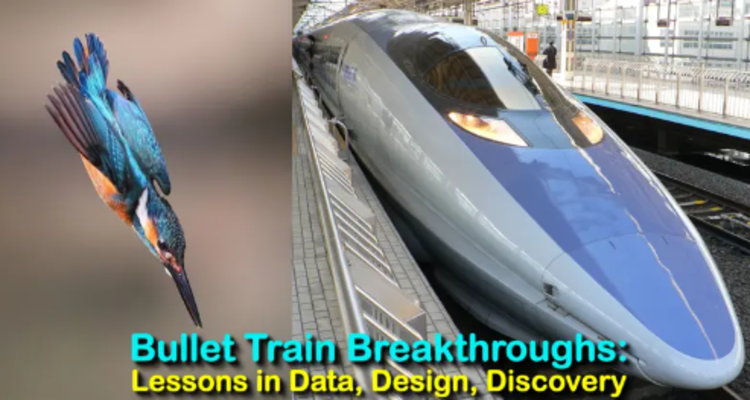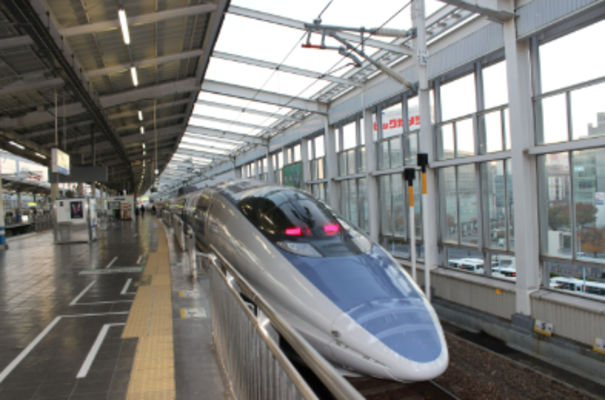
Bullet Train Breakthroughs: Lessons in Data, Design, and Discovery

Did you know that the Japanese Shinkansen bullet train, a remarkable feat of engineering, originally encountered a significant design issue? When these trains would roar through tunnels in the early 1990s, they produced such powerful air pressure waves that extremely loud sonic booms could be heard once they came out. This noise was rather startling for passengers and seriously disturbing for nearby communities. Consequently, as this was much more than a minor annoyance, engineers were tasked to find a way to minimize the disruption without reducing the train’s speed.
A Solution Inspired by Nature
 Inspiration for the solution came from the most unlikely place: nature. A team of engineers, led by Eiji Nakatsu, who was both an engineer and a passionate birdwatcher, turned to the kingfisher, a bird that dives into water at high speeds without causing a splash. This is due to the bird’s very streamlined beak, allowing it to slice through air and water with ease. The engineering team adopted this concept, redesigning the bullet train’s nose to resemble the kingfisher’s beak.
Inspiration for the solution came from the most unlikely place: nature. A team of engineers, led by Eiji Nakatsu, who was both an engineer and a passionate birdwatcher, turned to the kingfisher, a bird that dives into water at high speeds without causing a splash. This is due to the bird’s very streamlined beak, allowing it to slice through air and water with ease. The engineering team adopted this concept, redesigning the bullet train’s nose to resemble the kingfisher’s beak.
This led to a significant reduction in noise pollution, 15 percent more energy efficiency, and a 10 percent increase in speed. What started off as a problem turned into a groundbreaking innovation, one that came from three key principles: observation, adaptation, and application.
What Does This Have to Do with Data?
If you think about it, leveraging data effectively follows the same principles. Just like engineers had to analyze and apply insights from nature, data-driven decision-making requires us to observe patterns, adapt strategies, and apply solutions in innovative ways. Here are three parallels to consider:
- Observation: Just like Nakatsu watched the kingfisher diving effortlessly, we have to look closely at patterns, inefficiencies, and opportunities being uncovered by data.
- Adaptation: The engineers didn’t just admire the kingfisher; they applied the principles of its design to address a real-world problem. Just like raw data is not enough, we need to translate it into meaningful insights driving action.
- Application: The redesign of the bullet train resulted not just quieter, faster travel, but also efficiency gains. Today, the best data strategies ensure performance gains, efficiency losses minimized, and new opportunities created.
History’s Data-Driven Innovators
Borrowing an idea from one sector and innovatively applying it in another is not a new concept. One of the most famous examples might be Henry Ford’s assembly line. Ford revolutionized automobile manufacturing by observing meatpacking lines and how they moved animal carcasses along their conveyor belts. Adapting that mechanization to his factory, Ford was able to streamline production from 12 hours for each car to a mere 90 minutes, a feat that would change the character of manufacturing forever.

Assembly line workers inside the Ford Motor Company factory at Dearborn, Michigan. (Photo by Hulton Archive/Getty Images)
This is exactly what great data leaders do today. They seek insights beyond their immediate industry, connect dots others don’t see, and apply solutions in ways that create extraordinary results.
The Three R’s of Data-Driven Success: Rhythm, Relevance, and Resilience
Much like the Shinkansen’s evolution, success in leveraging data comes down to three crucial elements:
- Rhythm: A high-speed train runs on a precise schedule. In much the same way, data strategies must be consistent and well-orchestrated to drive decision-making.
- Relevance: Data, like the kingfisher’s beak, must be shaped for its environment. That means curating the right datasets, cleaning out noise, and ensuring the insights align with real-world applications.
- Resilience: Bullet trains endure extreme weather, high speeds, and complex terrains. Similarly, data frameworks must be built to withstand change, uncertainty, and evolving business needs.
 A Twist in the Tracks
A Twist in the Tracks
At this point, you might be thinking: Alright, Dr. Joe, I get it; data leaders should take inspiration from nature and history. But where’s the surprise twist?
Here it is: The bullet train’s original design was considered “state-of-the-art” before the noise issue emerged. Engineers thought they had a perfectly optimized system, only to discover they were missing a critical element. The breakthrough only came when they were willing to challenge their own assumptions and look outside their domain for a better answer.
This is precisely the challenge many organizations face with data. Some might call this strategy “Thinking outside the box.” They assume their current approach is good enough, that their dashboards tell the full story, or that their AI models are capturing the right insights. But without looking beyond their current paradigms, that is, without seeking inspiration from other industries, disciplines, and even nature itself, they may be missing out on game-changing breakthroughs.
Final Thought: Inspiration Is Everywhere
The lesson of the bullet train is clear: breakthroughs don’t happen in a vacuum. Whether in engineering, business, or data strategy, true innovation comes from observing, adapting, and applying insights in unexpected ways. As the great Steve Jobs once said: “Creativity is just connecting things.”
So, let’s challenge ourselves to connect the dots others ignore, embrace insights from unlikely places, and engineer the future, one well-informed decision at a time. After all, if a bird can inspire the world’s fastest train, imagine what your next data insight could do.
EPILOGUE: This article was inspired by a short video I created for Insight Jam a couple of months ago. Check it out here.

 - by
- by






